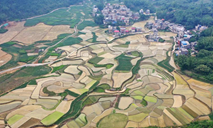Miao ethnic people start new life after poverty alleviation resettlement
CHANGSHA, May 13 (Xinhua) -- A chunk of air-dry smoked meat hangs in the hallway of Wu Jinjian's residence in Fenghuang County, central China's Hunan Province, emitting a pleasant smoky flavor.
Four years ago, Wu and his wife along with their parents, and their three children left their hometown, a remote mountain village in Fenghuang County. As part of the local poverty alleviation program, they relocated to a three-story building in the resettlement area in the center of Heku Township.
In 2018, the local government built 756 new buildings in Heku Township for poor households looking to relocate. A total of 4,784 people from 932 poverty-stricken Miao ethnic households were gradually relocated to Heku from four surrounding townships.
The Heku resettlement area is the largest centralized resettlement area for Miao ethnic group in Hunan Province.
Not long after moving in, Wu's family fell in love with their new residence.
The newly constructed building features yellow walls, grey tiles, and arching eaves, showcasing the popular architectural style of the Miao ethnic group. Schools, hospitals, farmers' markets, and even a basketball court all help make life more convenient for the new communities.
Adapting to the new lifestyle, however, is a significant challenge for people from remote mountainous villages. Local government officials had to teach to them how to use new equipment, such as door locks, windows, gas stoves, taps, and toilets.
Of course, some people still hold a strong attachment to their hometown. They return to the villages where they used to live and work, and visit their relatives, said Shi Chengbang, Party chief of Mituo Village.
Art groups, including ethnic dance and folk music groups, have been organized to preserve the culture of local ethnic minorities. Relocated villagers can also earn some money via the performances presented by these groups.
The government has established clothing and luggage manufacturing industries in the resettlement area to create jobs for the relocated villagers in order to sustainably increase their income. Meanwhile, jobs for public services, such as cleaners and guards, are also available in their new communities.
After the resettlement, villagers have found they have more business opportunities, and some relocated households have started to run small shops or stalls.
Since 2015, the Chinese government has implemented poverty alleviation relocation programs to address the needs of nearly 10 million poor people and help lift them out of poverty. By the end of 2020, a total of 35,000 resettlement areas were built across the country and more than 9.6 million people bid farewell to old villages and embarked on a journey to establish a new life.
Photos
Related Stories
Copyright © 2022 People's Daily Online. All Rights Reserved.










